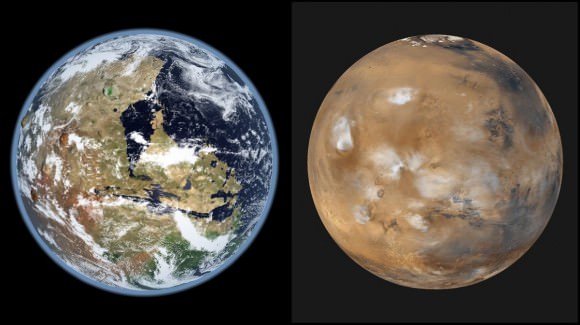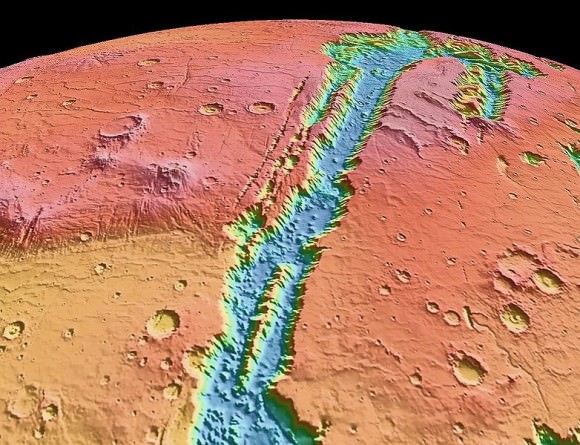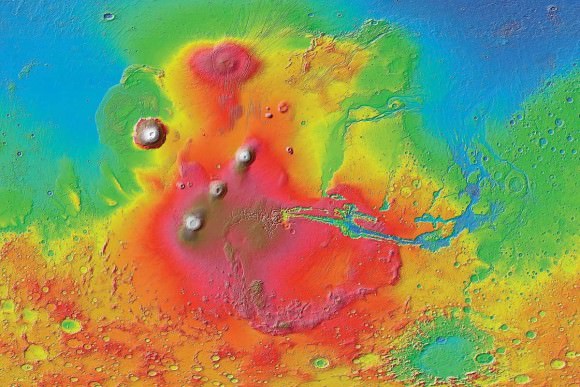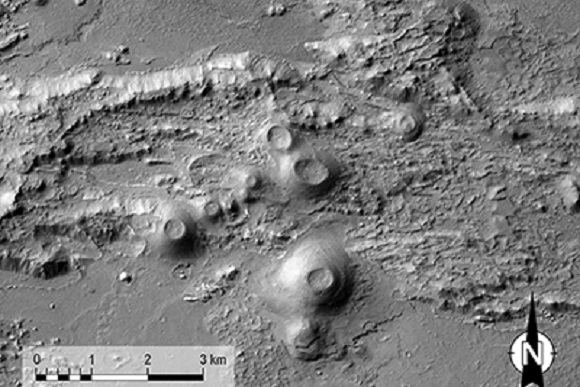
For decades, Mars has been the focal point of intense research. Beginning in the 1960s, literally dozens of robotic spacecraft, orbiters and rovers have explored Mars’ atmosphere and surface, looking for clues to the planet’s past. From this, scientists now know that billions of years ago, Mars was a warmer, wetter place. Not only did liquid water exist on its surface, but it is possible life existed there in some form as well.
Granted, some recent findings have cast some doubt in this, indicating that Mars’ surface may have been hostile to microbes. But a new study from an international team of scientists indicates that evidence life could be found in volcanic deposits. Specifically, they argue that within the massive geological structure known as Valles Marineris, there may be ancient volcanoes that have preserved ancient microbes.
The study, titled “Amazonian Volcanism Inside Valles Marineris on Mars“, recently appeared in the journal Earth and Planetary Science Letters. Led by Petr Brož of the Institute of Geophysics at the Czech Academy of Sciences (AVCR), the team examined Mars’ famous Valles Marineris region – a canyon system stretching for 4000 km (2485.5 mi) – for signs of recent geological activity, which opens up the possibility of there also being fossilized life there.
The team began by examining the Coprates Chasma canyon, one of the lowest points in Valles Marineris, which is home to over 130 volcanoes and solidified lava flows. This consisted of analyzing high-resolution images of the region that were taken by NASA’s Mars Reconnaissance Orbiter (MRO), which revealed cones of basaltic lava (aka. scoria) and ash that measured around 400-meters (1300 ft) high.
After examining the cones’ surface patterns and morphological details, they confirmed that these were indeed the remains of lava volcanoes (and not mud volcanoes, which was another possibility). In addition, they also noted similarities between these cone and others on Mars where mud volcanism is not possible – as well as similarities with volcanic cones here on Earth.
As Ernst Hauber, a researcher from the Institute of Planetary Research at the German Aerospace Center (DLR) and a co-author on the study, explained in a AVCR press release:
“The spatial distribution of the cones also suggests their volcanic origin. They appear to occur more frequently along tectonic fractures that formed the trough in the surface and whose fracture interfaces continue into the subsurface, creating pathways for the magma to ascend.”Even more surprising was the apparent age of the volcanoes, which was very young. On Mars, the main period of volcanic activity ended during Mars’ Hesperian Period – which ran from 3.7 to approximately 3.0 billion years ago. And while images acquired by the Mars Express mission have shown indications of younger volcanoes (occurring 500 million years ago), these tend to be located in volcanic provinces.
A colorized image of the surface of Mars taken by the Mars Reconnaissance Orbiter. The line of three volcanoes is the Tharsis Montes, with Olympus Mons to the northwest. Valles Marineris is to the east. Image: NASA/JPL-Caltech/ Arizona State University
In contrast, the volcanic cones spotted in the Coprates Chasma canyon were estimates to be between 200 and 400 million years of age, placing them in the most recent geological period known as the Amazonian (3.0 billion years ago to the present day). This effectively demonstrates that these volcanoes formed late in Mars’ history and far away from volcanic areas like Tharsis and Elysium.
It also demonstrates that these volcanoes were not part of the original formation of Valles Marineris, which is believed to be related to the formation of the Tharsis Bulge. This all took place between the Noachian to Late Hesperian periods of Mars (ca. 3.5 billion years ago), which was the last time Mars experienced widespread geological activity.
Last, but not least, the team used the Compact Reconnaissance Imaging Spectrometer (CRISM) aboard the MRO to learn more about the mineral compositions of the region’s lava and volcanic cones. Once again, their findings proved to be surprising, and could indicate that the Coprates Chasma region is a suitable location to search for evidence of ancient life on Mars.
Image of young volcanoes at the base of Coprates Chasma on Mars, obtained by the Mars Reconnaissance Orbiter. Credit: NASA/JPL/University of Arizona
On Earth, microorganisms are often found within opal deposits since they form in energy and mineral-rich environments, where microbial lifeforms thrive. The presence of these minerals in the Coprates Chasma region could therefore mean that ancient microorganisms once thrived there. Moreover, such organisms could also be fossilized within the mineral-rich lava rock, making it a tempting target for future research.
As Hauber indicated, the appeal of Coprates Chasma doesn’t end there, and future mission will surely want to make exploring this region a priority:
“Coprates Chasma is not just interesting with regard to the question of previous life on Mars. The region would also be an excellent landing site for future Mars Rovers. Here we could investigate many scientifically important and interesting topics. Analyzing samples for their elemental isotopic fractions would allow us to determine with far greater precision when the volcanoes were actually active.
“On the towering, steep walls, the geologic evolution of the Valles Marineris is presented to us almost like a history book – gypsum strata and layers of old, crustal rocks can be observed, as well as indications for liquid water trickling down the slopes even today during the warm season. That is as much Mars geology as you can get!”
Scientists were able to gauge the rate of water loss on Mars by measuring the ratio of water and HDO from today and 4.3 billion years ago. Credit: Kevin Gill
In the future, NASA, the ESA, the China National Space Agency (CNSA) and Roscosmos all hope to mount additional robotic missions to Mars. In addition, NASA and even SpaceX hope to send crewed missions to the planet in the hopes of learning more about its past – and possibly future – habitability. Between its geological history, greater atmospheric pressure, and the possibility of fossilized life, one or more of these missions may be headed to Valles Marineris to have a look around.
Further Reading: The Czech Academy of Science, Earth and Planetary Science Letters
The post Ancient Volcanoes on Mars Could Have Been the Place for Life appeared first on Universe Today.



No comments:
Post a Comment